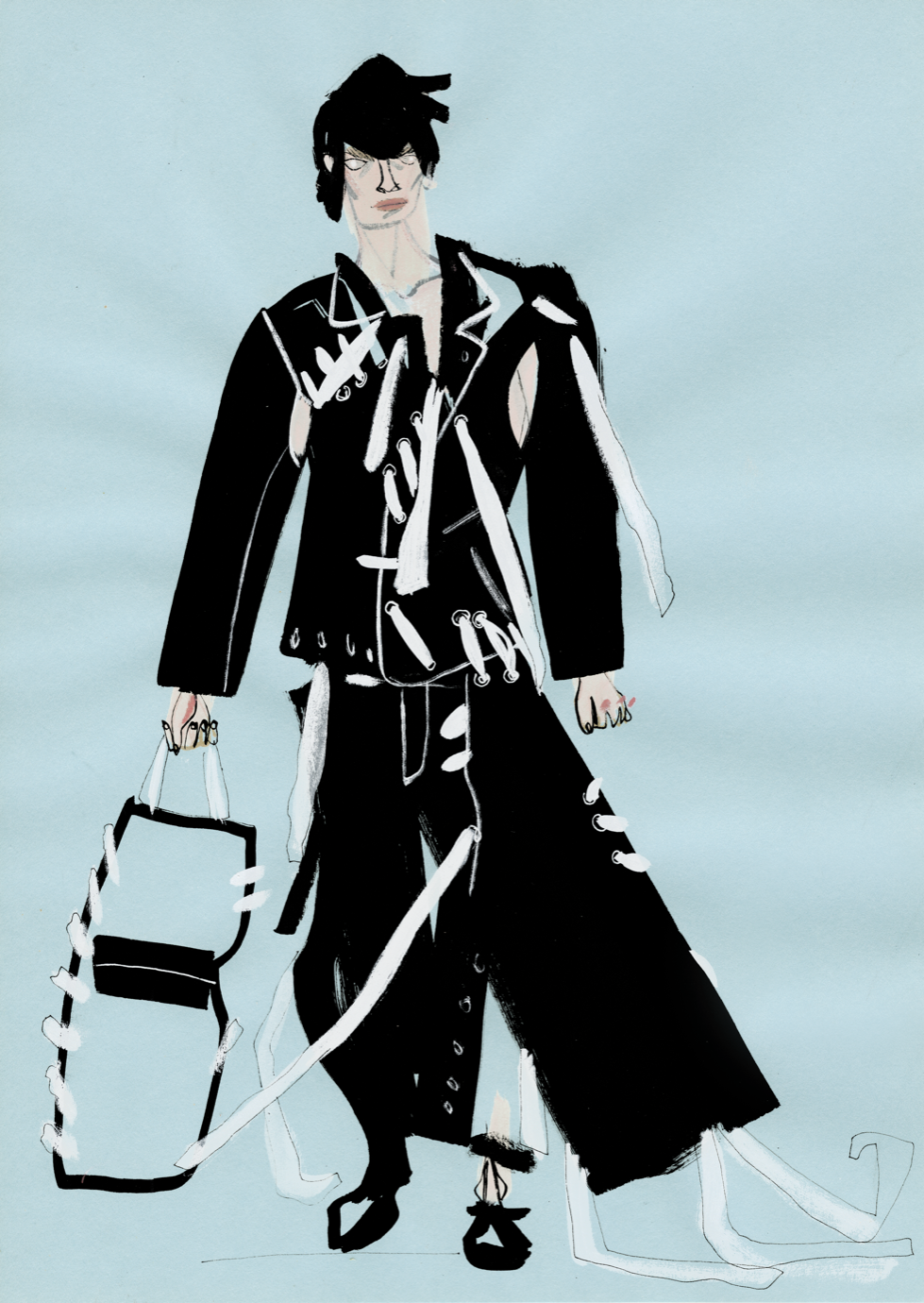Stavros Karelis, founder and buying director at Machine-A, an independent London concept store known for its mix of established designers like JW Anderson and new talent such as Stefan Cooke, is happy with this bold change of the unforgiving status quo, “We need to think about implementing a system that supports a bigger life duration of a product in a retail space. It’s not just about selling, but also about telling a story behind the brand and giving the customer time to find out about new designers and fall in love with products. Right now, there’s too much of everything and changes of seasons are too fast – not only designers can’t keep up, but also the consumers can’t absorb it all.”
“We need to think about implementing a system that supports a bigger life duration of a product in a retail space.” Stavros Karelis
For the time being, the cycle has been moved to the digital sphere, with London’s first iteration taking place during the previously scheduled London Fashion Week Men’s, from 12th to 14th June. The newly-launched platform will merge womenswear and menswear designers on one gender neutral platform and put the emphasis on storytelling – “Designers will be able to share their stories, and for those that have them, their collections, with a wider global community; we hope that as well as personal perspectives on this difficult time, there will be inspiration in bucket loads. It is what British fashion is known for,” said in a released statement Caroline Rush, BFC’s chief executive.
“I worry that designers are feeling the pressure to create and be a part of this in order to remain relevant, when perhaps they might not be in the best place to be doing so.” Emma Davidson
The question remains: is a fashion week within a health crisis necessary? Emma Davidson, fashion features editor at Dazed Digital, thinks this move is slightly conflicting with the larger conversations in the industry regarding slowing down, “I worry that designers are feeling the pressure to create and be a part of this in order to remain relevant, when perhaps they might not be in the best place to be doing so. For all the people I speak to who are finding themselves really inspired to create during this time, equally there are those who are just managing to keep it together on a more basic level.”
Dan Thawley, editor-in-chief of A Magazine Curated by, also finds the decision to host an online substitute at this moment unnecessary, “I would prefer to see the cycle paused and the unsold product in stores longer. I think that a fashion week in any form, digital or otherwise, would be better in September for both men’s and women’s. I don’t think it is fair to expect designers to be able to give their best under these conditions – however they do say that the greatest creative leaps and bounds do often happen in darker times.”
On a positive note, introducing fashion week to the digital realm might make the event more accessible to emerging talent . “The money that it costs to orchestrate a show is monumental and without the support of initiatives like Fashion East and NEWGEN it’s incredibly hard for young designers to show their work and get the attention they deserve – I hope that shows going digital might open the industry up to more creative talents that don’t have the backing to be able to show in the physical realm,” says Davidson.
Taking fashion week online can also allow designers to discover new ways of expression and connecting with the audience. In Thawley’s view, the key aspect is for brands to recognise their strengths and resources, “I would like to see technology play either a subtle and classic (as such, invisible and seamless) part or truly new forms of AR and VR come into play for brands who have the capabilities and the aesthetic suited to such possibilities. If you can’t afford to innovate, why not go super personal? No one needs to see a shaky livestream or a bad fashion film. As an editor, I appreciate the personal time that designers dedicate to explaining their work. Why not transform those moments into more accessible conversations, not only ones that occur behind closed doors with the select few?”
The digital nature of fashion week puts the role of buyers in a precarious position, with social distancing guidelines forcing them to make decisions based on a purely visual basis. “We’ve done buying in this way with certain brands in the past, but once you have a longstanding relationship with a designer, you can recognise the structure and quality of the garments in a much better way. The challenge will be to understand these factors with brands that are just coming out, so hopefully they will figure out a way to showcase these aspects as clearly as possible, while at the same time evoking beauty and emotions – that’s the most important thing right now,” explains Karelis.
“Maybe going digital will see the last dying embers of elitism within the industry extinguished.” Emma Davidson
The new format of this event is undoubtedly bringing wider access to the notoriously exclusive world of fashion. Stuart Williamson, fashion editor at Fantastic Man magazine, says he’s happy to see this progress, “Fashion has a huge global audience right now and brands have been opening to it with livestreams and surrounding content in the past few years, which I’m all for. The only thing I’m sad about is losing the sense of occasion that comes with shows – the venue, the light or even the smell. But of course, nowadays you can also convey the essence of the brand in new ways digitally and I’m really excited to see what people come up with.” Davidson agrees that bringing fashion week online will further grow the process of democratization, “Maybe going digital will see the last dying embers of elitism within the industry extinguished.”
In Thawley’s opinion, although the way brands are documenting and promoting collections through social media, video channels and websites will remain key for audience engagement, organisers will still implement elements of exclusivity that have already been tested, such as password-secured websites and private online press rooms. He also believes the digital realm might negatively affect the act of discovery. “I think what we are already seeing as the effect of social distancing and travel bans is a concrete lack of spontaneity in the way we connect with people today – even in a Zoom conversation you can’t branch off and turn away and speak to another person, have a private chat in a corner, or randomly meet someone you hadn’t expected to see. All of these things are certainly a part of the magic of fashion’s social interactivity that often leads to great things,” he says.
“I think nowadays, designers from both sides of the field have equally loyal fans that will actively search for the collections.” Jack Cassidy
With fashion week going co-ed, is there a fear of menswear designers getting lost in the avalanche of coverage women’s designers tend to get? Williamson says that with the recent steady rise of interest in menswear, as well as non-gendered fashion, this should not be a concern, “I think nowadays, designers from both sides of the field have equally loyal fans that will actively search for the collections. Also, with all the brands showing together, you are more likely to come across something that you are really into and want to try out, but haven’t considered before.” Jack Cassidy, head of menswear buying at Selfridge’s, agrees that this merge is a natural progress, “Prior to the current situation we were already entering an age of fashion week schedules that were testing the confides of menswear and womenswear and I personally think this makes for a really dynamic and multi-faceted schedule and experience.”
Most successful fashion is often a reflection of the times, so should upcoming presentations make references to the COVID-19 pandemic in their messaging? Thawley has no doubt that we will see allusions to lockdown reality, with aesthetic decisions linked either to political and scientific concerns or domestic trends, such as baking, partying at home and wellness regimes. However, he hopes that designers will carefully toe the line between making a ‘confinement’ statement collection and continuing their evolution and story from previous seasons. “I don’t think it’s the time for anyone to make any sort of grand about-turn in their aesthetic, but rather time to continue to keep craftsmanship, longevity and traceability in the forefront of design, garment-making, shipping, promotion and all other avenues that create waste in the fashion ecosystem,” he says.
The upcoming digital London Fashion Week will be an atypical experience and should be treated as such, with no pressure for designers to perform as usual. With all of its technical challenges come many possibilities to gain recognition and connect with new audiences. Davidson says, “With a whole new realm to explore and a lot of noise to cut through, I hope designers don’t lose sight of themselves and what they do in a bid to stand out from the crowd.” The key focus is to stay authentic to the brand narratives and create work that is rich in emotion.









